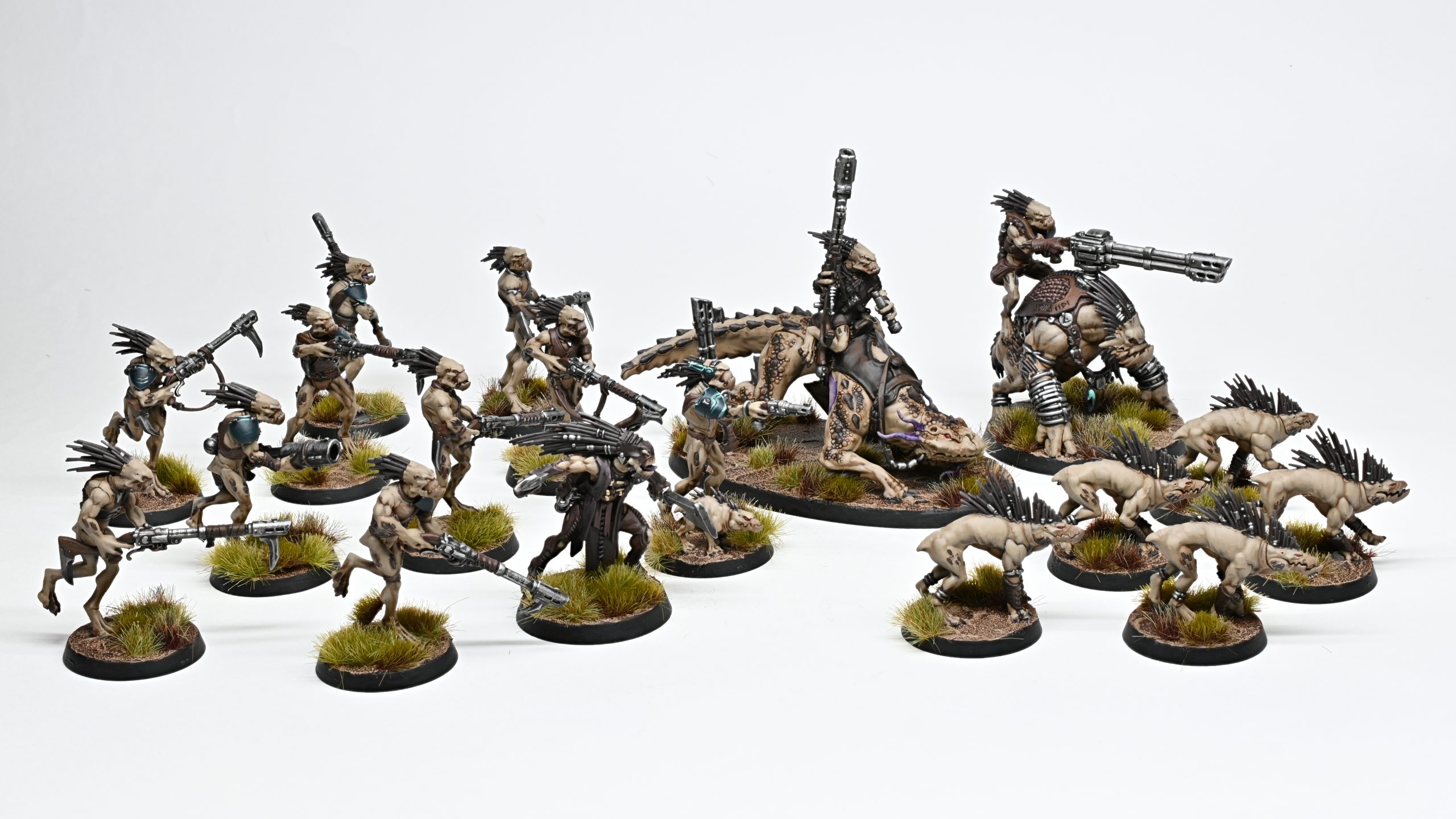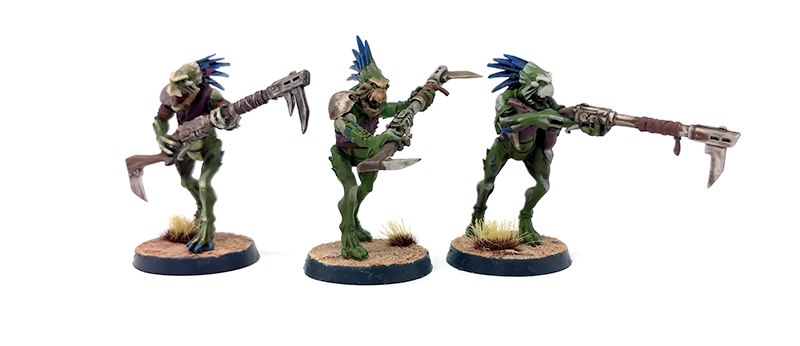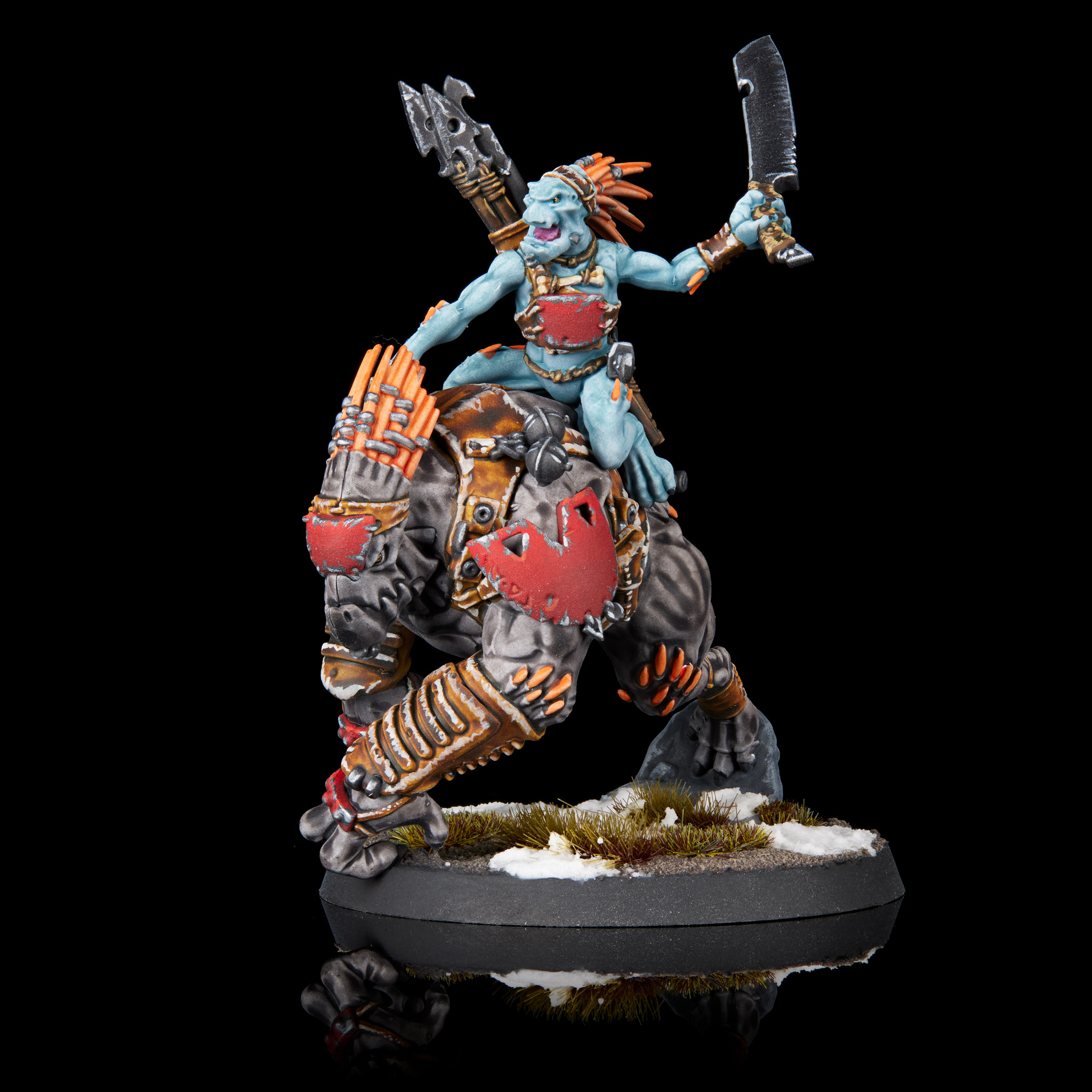Continuing a welcome recent trend of publishing new Crusade rules in White Dwarf, this month’s White Dwarf #504 has rules for running Kroot armies in Crusade, adding new campaign rules, agendas, traits, and artefacts for the mercenary warbands. But are they any good? In this article we’re taking a deep dive into the rules to find out.
Mustering your Kroot Armies
So you’ve gone out and purchased Codex T’au Empire, read the book that is filled with giant robots, battle suits and powerful tanks and have for some reason decided that “no, I want to travel the galaxy with my army of space dinosaurs to meet new and interesting people… and then kill them to consume their flesh in order to evolve.” Not sure how that works when you’re fighting the Necrons but it’s probably some sort of space voodoo and really isn’t worth thinking too hard about..
In order to muster your army of cannibalistic bin chickens, at step 3 where you would select an Army Faction, instead of T’au Empire, you can now select Kroot even though it’s not found in the Faction keyword of your unit’s datasheets. If you do this, you can’t take a T’au Empire model as your Warlord, and the amount of non-Kroot units you can take in the army are capped at 500 points for Incursion, 1,000 in Strike Force, and 1,500 in Onslaught. Note that you can still use the For The Greater Good ability despite your Army Faction not being T’au Empire. This is primarily to help handle the fact that there aren’t that many Kroot units, and their points costs aren’t super high, so filling an entire 2,000-point army with Kroot is a bit of a challenge.
Beanith: That said, everything written so far can be largely ignored as everything in this article doesn’t actually need you to be running a Kroot Army. The Agendas, Requisitions, Battle Traits and Relics only require the Kroot keyword. The Shapers of Pact only requires you having a Kroot Character in your Crusade force and three of the seven methods to scoring Pact points can be fulfilled by non-kroot units so you can easily Expand your Empire with your fishie bishies while your angry parrots run merc jobs on the side.
TheChirurgeon: Yeah, I think that’s good, since there isn’t enough stuff in the Kroot sections of the T’au Codex to run a full army, even with the new additions to the range, but it’s also a little lame that you’d run these without running just Kroot.

Shapers of Pacts
The Kroot are not really big on the whole Greater Good that the T’au like to bang on about, instead finding their virtue as mercenaries striking deals with even the most questionable employers so long as it has the opportunity to gain strength and security for their pack. Just so long as the local Ethereal isn’t paying too much attention…
Pacts are the main Crusade rule for Kroot armies, representing the army taking mercenary jobs for various employers away from their T’au allies. In gameplay terms, these are called Pacts – though they bear no relation to the Chaos Space Marine variety.
Pact Shaping
So long as you have a Kroot character in your Crusade force, you can shape a Pact, taking on a new employer to do some odd job for. When you do this you randomly generate three traits by rolling a D6 on three separate tables to generate an Employer, The Task, and the Difficulty level of the task.
This is largely narrative as you’re only really concerned with the dice roll itself – high rolls are generally better but come with a greater chance of suffering setbacks every battle. That said, the risk is good – the combined total of all three Ratings represents your Points Target, the number of Pact points you’ll need to accumulate to complete your Pact. And generally speaking you want that number to be 11+ to get the cool Shapers of Flesh Battle Honours.
TheChirurgeon: This system feels really great and I like how it encourages you to think more about what your army is doing and why – the random tables here do more to help build creatively than substitute for it, and in turn that can lead to some very cool storytelling.
Setbacks
Whilst your Crusade force is bound to a pact, after the Muster Crusade Armies step of each battle you will need to roll a D6 and roll higher than the Rating for your Pact’s Employer rating and Difficulty rating. Thankfully a 6 is an autopass so there is a chance to avoid Setbacks even when working for a Terrifying Warlord (6) on a Dangerous (6) Terror Raid (6).
On the very real chance of you failing this roll, your army is now affected by a Setback and you roll a D6 to find out just how boned you are. Ambushed deals D3 mortal wounds to your Warlord; Betrayed subtracts 1 from Out of Action Tests; Doubting the Pact lets your opponent select on your units to become Battle-shocked on a 2+ during any Command phase; Isolated blocks Reserves from showing up in the first two rounds; Outmatched is an extra CP for your opponent; and Waylaid ‘forces’ you to randomly select a unit from your army not in Reserves and stick them in reserves.
At the end of the battle you’ll make progress toward your Pact, scoring Pact points for completing various tasks, though which you’ll score depends on your task. You get 1 point automatically for completing a battle and 1 point for winning, but then your other points is based on task – if your task is Assassination, then you’ll score an additional point for each enemy CHARACTER killed by a Kroot unit from your army. In Scouting Tasks you’ll score 1 point for each Kroot unit you have wholly within 9″ of the opponent’s table edge at the end of the battle. These points are then added to your total, and if you’ve hit your pact points target, congratulations – you’ve completed your pact!

Completing a Pact
There are several ways of gaining Pact points and some of them depend on the nature of the Task you rolled for when you Shaped the Pact. As we mentioned above, you’ll score Pact points for playing games, plus each of the Kroot Agendas offer ways of gaining additional points if achieved in battle and there’s the usual Coward’s Requisition to speed things along.
Once you’ve collected all the Pact points required, you can now turn them in for your Pact Rewards. As mentioned, lower rolls for your Pact decrease your risk (and reduce the number of setbacks you’ll deal with), but also decrease your rewards – your reward depends entirely on the Pact’s points target.
- Meagre Returns (Pact points 3-6) gives a Kroot Character 2XP and a firm handshake, this will also inspire you to do better on your next Pact letting you reroll results of 1 or 2.
- Fair Remuneration (Pact points 7-10) bumps that sweet XP to a massive 3XP for a single Kroot Character. This is only slightly worse than Meagre Return because you don’t get the rerolls. You do however get a free Rearm and Resupply requisition to use on your next Kroot unit. Do better.
- Rich Rewards (Pact points 11-14) is where all your hard work starts paying off. You get the 3XP for a Kroot Character and in addition you get to use the Shapers of Flesh mechanic to add a new Kroot unit to your Order of Battle, and when you do, you can grant a single strain to it.
- The overachievers bring home the Warriors’ Wealth (Pact points 15-18). It’s still just the one Kroot Character getting 3XP but you can also add two new Kroot units to your Order of Battle and each of those units gains a single strain from the Shapers of Flesh.
These are solid rewards, and after you collect them you reset your pact points and generate a new pact, going back to the mercenary grind.
Abandoning a Pact
Lastly they’ve included a lever to pull when things look a little bit tough, or far more likely, you’re looking at a possible Fair Remuneration reward. Before or after a battle, you can abandon your current Pact and shape a new Pact. However, when you generate your new pact, you must re-roll results of a 5 or 6, ensuring you can’t just abandon pacts over and over in the hopes of generating really high-risk challenges.
Shapers of Flesh
The lore around the Kroot has always included notes about how they consume their enemies to shape their genetics, adding traits based on what they consume. This section details new Battle Honours (six in total) that you can give to Kroot units when they’re added to your Crusade force through completing a Pact or using a Requisition. You can’t give them at any other time. Strains increase your Crusade points by 1.
The effects here are all solid and reflect improvements in physical characteristics – Great Endurance gives your unit +2” Movement, Predatory Swiftness gives you re-rolls on Advance and Charge rolls, Corded Muscles gives you +1 strength on melee attacks, and Leathery Resilience gives you +1 Toughness. It’s some cool stuff, and some of these can make for really nasty Kroot units.
Agendas
The Kroot have five Agendas here, of which three – Safe Passage, A Feast for the Kinband, and Find and Retrieve – can earn you points towards your Pact while also scoring you XP for accomplishing various tasks. Trailblazers lets you give 1 XP to a single Kroot unit in each table quarter at the end of the battle. And the most interesting of the bunch is A Prize for the Shapers – you keep a prize tally for your Order of Battle and at the start of the first round of the game you pick an enemy Character. The Kroot unit that kills that Character unit gains 2 XP and you add 1 to your prize tally. When your prize tally is 3 or more you can spend your tally when you add a new Kroot unit to your force to have them start with one Strain from the Shapers of Flesh battle honours. This is solid and I like it as a way to added what are essentially Blooded Kroot units to your Order of Battle after your first few games.
Requisitions
The Kroot have four Requisitions. Reshape the Pact (2 RP) lets you change one aspect of your Pact (employer, task, or difficulty). All for the Greater Good (1 RP) lets you score extra pact points based on your ability to score XP off the Kroot Agendas. Sequester Artefact lets you gain an Artificer Relic if you scored 3+ points toward an Escort or Treasure Hunting Pact in a single game. And Fabled Hunter lets you add a Kroot Lone-Spear to your force, and they come pre-loaded with a Strain from the Shapers of Flesh section.

Battle Traits
Kroot have access to three battle trait tables, with three options each for Infantry units, Kroot Hounds, and Mounted units. These are on top of the options you get in Codex: T’au Empire, which just apply to all Kroot units. For Infantry units, my favorite trait is Predator’s Pounce, which prevents enemy units from Overwatching your unit. For Kroot Hounds I like either Canny Hunters (improve their AP by 1) or Sharpminded, which ups their OC by 1. And for Mounted Units I like Steedbond, which lets your unit move through models and terrain features less than 4” in height and through Engagement Range, giving you some cool mobility boosts.
Crusade Relics
There are six crusade Relics available to the Kroot: Three Artificer, two Antiquity, and one Legendary. These are just OK – none of them are really worth writing home about, save maybe the Legendary Relic, Totem of Prok. This isn’t a misspelling of “pork” but rather a cool reference to the Epic Hero Anghkor Prok, the Kroot Shaper Games Day mini that Games Workshop put out in 2001. This relic gives its bearer +2 Toughness, +2 Wounds, and 4+ invulnerable save, making them a really tough bird.
Beanith: They were one misspelling away from a Legendary Relic almost as awesome as the Vortex Grenade. Mmmmm Bacon totem
Final Thoughts
Beanith: Not bad for a White Dwarf article. Being able to muster a Kroot army is a nice touch only let down by the fact you can still have the giant battle suits and pathfinders tooling around with For the Greater Good ability. Very much a having your cake and eating it too situation but I don’t think we’ll be seeing too many Kroot faction armies taking over the galaxy any time soon.
Being able to run this alongside the T’au Expanding the Empire Crusade rules is pretty cool. You will take a little bit longer to complete the Pacts and suffer a few setbacks but what Kroot you are fielding will level faster because of it and gain some cool Shapers of Flesh strains to show off to the folks back home.
TheChirurgeon: I like these rules a lot. I wish they’d done a bit more with the whole “eat your enemies to gain their abilities” system, though – I think it would have been really cool to let Kroot units gain a bonus for eating different types of enemy unit, encouraging Kroot army players to branch out and eat new people. The only weird part about these is the interplay with Kroot and T’au units – being able to make a Kroot army is cool, but these rules tend to apply to the entire force, so you can create Pacts and use Kroot Agendas even for games and situations where you aren’t running Kroot armies. And I get why it’s set up that way, but it does seem a little lame – this is an area where I’d like to have Crusade faction and rules determined by the primary Warlord for your Order of Battle.
Otherwise, what’s here is cool, and it’s a good way to encourage Kroot armies, which I’m all for. More White Dwarf Crusade rules is always a good thing, in my opinion. If you want to run a Kroot army with your T’au force, these rules give you a good way to do it. And if you don’t, you can ignore them pretty easily.
Have any questions or feedback? Drop us a note in the comments below or email us at contact@goonhammer.com. Want articles like this linked in your inbox every Monday morning? Sign up for our newsletter. And don’t forget that you can support us on Patreon for backer rewards like early video content, Administratum access, an ad-free experience on our website and more.


